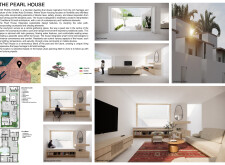5 key facts about this project
# Report on "The Pearl House" Architectural Design Project
## Overview
Located in Zone 2 of Dubai, "The Pearl House" is an architectural design that integrates elements of the United Arab Emirates' cultural heritage with contemporary living requirements. The project is formulated within the framework of the city's 2020 urban planning initiatives, striving to harmonize traditional aesthetics with modern principles of sustainability, flexibility, and enhanced comfort.
## Spatial Strategies and User Experience
At the core of The Pearl House is a central courtyard, inspired by traditional oasis architecture. This courtyard serves as a focal point for family and community interaction, featuring lush vegetation and water elements that contribute to a serene environment. The layout promotes natural light and airflow, enhancing thermal comfort and fostering outdoor connection.
The spatial configuration clearly differentiates between private and communal areas. The ground floor incorporates service zones, while designated family spaces enhance adaptability for varying lifestyles. Multipurpose furniture is strategically integrated, allowing the living areas to seamlessly transition between relaxation and functional use.
## Material Selection and Sustainability
The material palette of The Pearl House is carefully chosen to address both aesthetic and functional objectives. Concrete serves as the primary structural material, offering strength and longevity, while extensive use of glass enhances transparency, facilitating the connection between interior and exterior environments. Natural stone is selected for its thermal mass properties, coupled with wood elements that add warmth and character to the interiors. Additionally, plaster finishes provide a minimalist aesthetic throughout the building.
Sustainability is a fundamental aspect of the design, with strategies including solar studies for optimized passive energy usage, reducing cooling loads. Smart home technologies are implemented to enhance energy efficiency and user comfort, demonstrating a commitment to innovative and sustainable living solutions.




















































